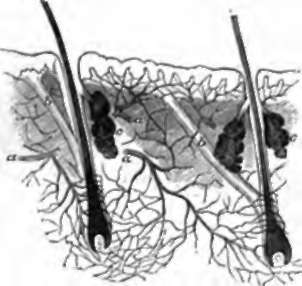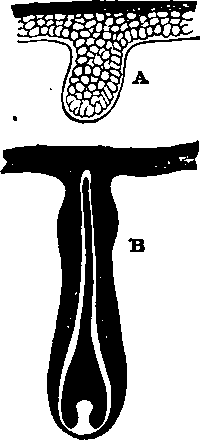48. The Shaft Of The Hair
Description
This section is from the book "Animal Physiology: The Structure And Functions Of The Human Body", by John Cleland. Also available from Amazon: Animal Physiology, the Structure and Functions of the Human Body.
48. The Shaft Of The Hair
The Shaft Of The Hair is in some instances cylindrical, and in others flattened, and the tendency to curling is connected with the form. Thus the straight hair of the North American Indian is cylindrical, and the negro's woolly hair is quite flat. The pigment, on which the colour depends, is diffused in variable degree through cortex and medulla; but the most curious point with regard to the medulla is its connection with the turning of the hair white. In that change there is a disappearance of pigment; but there is likewise the development in the medulla of numbers of closely set minute globules of air. Such air globules are also constantly present in the white hairs of other animals, and reflect the light from their surfaces. A hair may begin to turn white in any part of its course, or in patches at different points; and sometimes one may see in one hair some parts unchanged, some with the pigment gone, but without air globules, others with air globules, but with the pigment remaining, and parts with both changes complete. It will be observed, therefore, that the hair undergoes changes of nutrition in its whole length.

Fig. 41. Sectoin of Scalp, showing two roots of hairs, a, a. Blood-vessels; b,b, erector muscles of the hair; c,c, sebaceous glands.
These may take place with great rapidity; for at least one case has occurred in hospital, under medical supervision, in which the hair has grown white in a single night from anxiety, and there is, therefore, no reason to doubt the historical traditions of similar occurrences. The appearance in one night also of single white hairs without any special disturbance of the system, has been noted by competent observers, and is probably a very common occurrence.
The sensation of the hair standing erect from emotional or other causes is accounted for by the fact that a band of unstriped muscle descends from the corium, and is attached to the lower part of the hair follicle on the side towards which the hair is sloped, so that by its contraction it pulls the root of the hair into the vertical position.
The first commencement of a hair in the embryo consists of a thickening of the cuticle by growth downwards into the corium; and within the mass of cells so deposited the form of the hair makes its appearance with a slender shaft and a large bulb, into which a papilla from the corium projects. Then, in the process of growth, the young hair bursts through the cuticular sheath in which it has been enveloped, and projects on the surface.

Fig. 42. Development of a Hair. A, Downward growth of epidermis. B, Form of the hair completed before appearing on the surface. After Kolli-ker.
Continue to:
